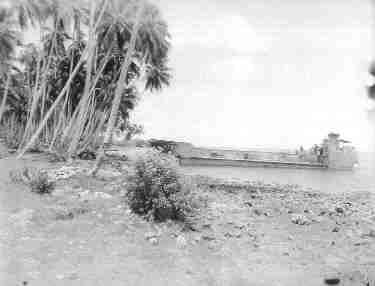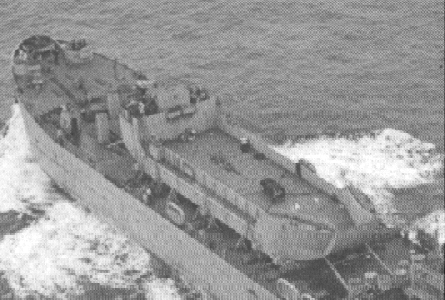In August 1941 K.C. Barnaby, of Thornycroft put forward the idea of a double -ended ramp LCT(Landing Craft Tank) for work with LST's(Landing ship tank), this was before the LCT mk4 was on the drawing board.At that time this design was not considered suitable for cross-channel operations.However the American Bureau of Ships designed the LCT Mk5 along the lines of Barnaby's suggestion but with only one bow ramp and the crew quarters aft.The Mk6 LCT's would be the first to be built with double-ended ramps.The Mk5 and her successor the Mk6 could be transported over seas on the decks of LST's and then side-launched
The LCT Mk5 was a broad-beamed craft(32ft. 9in.) and 112ft. in length and the tank well deck above the waterline.Although the Mk5 was originally designed to carry and land tanks they were used for many different operations.They became a work horse for the Navy carrying cargo, vehicles and tanks from ship to shore. Some were converted for other duties which included,The Landing Craft Gun, Equipped with destroyer armament for use against coastal shipping,Landing Craft Tank (Rocket)which could carry over a thousand rockets that were released in 24 salvoes. and other uses from Minesweepers to a Garbage Scow.
LIFE ABOARD
Although many of the Mk5s were used for training after 1943, they and the Mk6s could be taken by LSD or towed for long passages to Pacific operations, and at least one flotilla No 31 with twenty-four Mk6s - made an island-hopping passage from Pearl Harbour to Leyte under their own power between 15 January and is April 1945. Three months later, Groups 91 and 92 of this flotilla had six days of wild seas in a typhoon off Okinawa. By the morning of Friday 28 July they had made only twenty-Six miles in the previous seven hours, with men taking short spells at the wheel to hold their craft as she catapulted down 40ft waves into the dark troughs before the next mountain of water. That evening they changed course into the Force 7 gale and some craft stretched the I 1/4in bolts that held the sections together, but a further change of course put the seas on the starboard quarter and the craft prepared to run before the mounting storm. In close company, any major landing craft was difficult to hold on station; in a typhoon, trying to stop was impossible as great seas swept one craft hundreds of feet past the ship ahead. Even if the ship ahead was visible in the torrential rain there was little chance of avoiding her once another craft came too close astern, so the LCT flotilla leaders' signalmen risked their lives to flash lights as a guide when the craft spread out. Some LCTs broke down and lay across these great seas in grave risk of being tossed over, nearly all having their radio aerials and much else carried away. But they hung on, repairing engines and rudder cables, until the storm abated a little and all reported themselves still afloat on Monday evening. By 2120 hours on Tuesday the weather had moderated sufficiently to enable a course for Okinawa to be re-set. Not all life in LCTs was as hectic as this, but from the early days of the Royal Navy's LCT operations supporting the Eighth Army in North Africa, when ill-ventilated quarters made living aboard intolerably hot, through all major and most minor operations, LCT crews consolidated their reputation for delivering the goods. Many will remember the rumble of the ramp'door as it juddered down, and the final thump when the winch-man took his foot off the brake. Already the first officer had come down from the bridge and up on the bow, signalling directions for his skipper as the LCT nosed into the beach. The Number One now watched to see if the ramp splashed into shallow water, while the Skipper turned aft, listening for the kedge-winch party's report of success or a foul-up. In harbour, however, an almost studied lack of routine on many of these craft caused concern to the Admiralty and no doubt to the US Navy Department, though the author can trace no record of LCTs failing to land through indiscipline, but there are plenty of recorded occasions when they landed their cargoes despite bad weather, engine breakdowns, and enemy fire.(2)
When a new skipper arrived to take over one LCT in the south Pacific, his predecessor greeted the newcomer clad only in shorts, holding a can of beer in each hand. The new captain, freshly arrived from the states, was advised to take it easy and let the crew show him the ropes. The advice was willingly taken but had unexpected consequences: Very much aware that he knew little about conning the craft, the novice skipper had not been much more than a bystander upon returning from his first operation. His experienced crew made the landing smoothly and without incident; the captain was more than a little surprised when a messenger arrived from the flotilla commander requesting his presence. The green skipper was even more suprised when the boss suggested that he probably could tape over the pilot house portholes since his ship handling was so good! Needless to say, the novice made it his top priority to learn how to handle his vessel. (8)
 |
LCT 475 landing troops, location is unknown.
| Hull Dimensions Length | 112 ft. 4 in. |
| Hull Dimensions Beam | 32 ft. 9 in. |
| Displacement | 286 tons (short tons)* |
| Draught forward | 34 in. |
| Loads carried (max tons) | 150 tons (short tons)* |
| Crew | 13 |
| Engine make | Gray |
| Horse power | 225 |
| Number & Type | 3 Diesel |
| Props | 3 |
| Max speed | 7 knots |
| Range in miles | 700 at 7 knots |
| Armour in the wheelhouse | 2 1/2 in. |
| Armour in the gunshields | 2 in. plastic ? |
| Armament | 1 20 mm antiaircraft gun |
| Armament | 2 50 cal. machine guns |
* Short ton = 2000 lbs U.S. Long ton = 2240 lbs Great Britain
 |
The LCT 376 was Commissioned some time in 1942 and assigned to LCT (5) Flotilla Five under the command of Lt, Cdr. Paul A. Wells,USNR and was sent to the South Pacific .On the 14th of May 1943 12 LST's of flotilla five arrived in Noumea, each carried an LCT on her main deck that was soon launched by the simple expedient of listing the LST and knocking the blocks from beneath the LCT's. The slow-moving LST's manned chiefly by reservists who had never been to sea before took sixty days to make the passage from the United States. (8)(1)
 |
LCT siting on the deck of a LST on their way to the south Pacific.
The official record of their passage is hardly the stuff of a bestseller, but by reading between the lines, one can visualize the transformation of green sailors and untried ships into a cohesive fighting unit. The flotilla departed New York harbor on a frigidly cold day in March and headed south for bermuda. From there, the course was to Panama, through the Canal and on to Bora Bora. The initial entries in the flotilla log record a continuing battle with engine breakdowns, near collisions, missed flag or light signals, and ships falling out of formation. Human failings are noted in Panama, where a couple of sailors deserted. When Bora Bora rose over the horizion on April 23, 1943, 6,655 miles of practics meant that formation keeping had become much better and the breakdowns greatly reduced.With their arrival, Admiral Halsey's plan to capture Manda in New Georgia, code-named Operation Toenails was now possible.(8)
LCT (5) Flotilla Five was comprised of:
LCT Group 13
LCT Division 25: LCT's 58, 60, 156,158, 159, 180
LCT Division 26: LCT's 62, 63, 64, 65, 66, 67
LCT Group 14, commanded by Lt. Decatur Jones, USNR
LCT Division 27: commanded by Lt. Decatur Jones, USNR
LCT's 321, 322, 323, 324, 325, 326
LCT Division 28, commanded by ????
LCT's 367, 369, 370, 375, 376, commanded by Lt.(jg) Francis J. Hoehn,USNR
(he was the senior LCT skipper in the division--he may have also been the
division commander),377
LCT group 15
LCT Division 29:
LCT's 181, 182, 327, 330, 351, 352
LCT Division 30:
LCT's 68, 69, 70, 71, 481, 482
 |
The LCT 482 landing trucks on the Island of Emirau.(6)
All Landing craft were organized under Rear Adm. George H. Hall's Landing Craft Flotillas, South Pacific Force.Hall's command was a component of Real Adm. R.K. Turner's Amphibious Force for the Third Fleet, In preparation for Operation Toenails (New Georgia landings in June 1943 see map )Note:At this time in the war the LCT 376 would have been manned by it's first crew.
LandCraftFlots consisted of the following flotillas:
Of these numbers, 11 LST's, 23 LCI's, 35 LCT's and 10 APC's were available to participate in the initial landings in the New Georgia campaign.(1)
By the beginning of 1944 the allies had full control of the Solomon Islands and operation "CARTWHEEL", to encircle and isolate the Japanese air and naval bases at Rabaul and Kavieng was coming to a close and they would be isolated until the end of the war.On February 29, 1944 the U.S. army 1st. cavalry division landed on the Island of Manius in the Admiralty Islands.Manius would become a major forward base designated as a lion(minor bases were designated as cubs). Seeadler harbor was big enough to hold the 7th fleet and provided logistics for the fleet in its advance to the Philippine Islands.(8)(3)
 |
Click here for a full sized map
On March 20,1944 the 4th Marine division landed unoppose